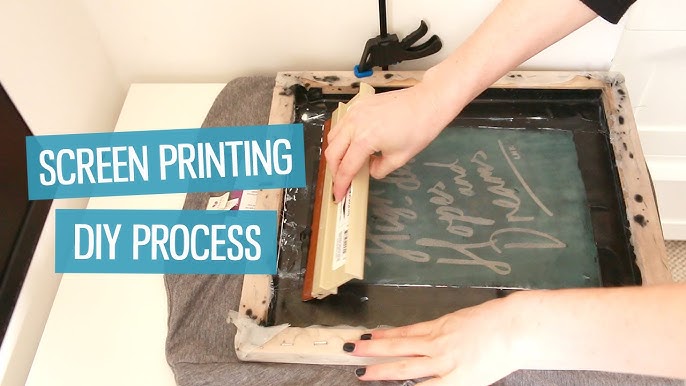ChatGPT said: How to customize your apparel with 10:9 Design Screen Printing in 3 easy steps
The Essential Overview to Recognizing Screen Printing and Its Versatile Utilizes
Screen printing has an abundant history that goes back to ancient times, progressing right into an innovative technique used across different sectors today. This overview discovers the ins and outs of the screen printing procedure, outlining its applications in advertising and marketing, style, and home décor - 10:9 Design Embroidery. Recognizing these fundamentals can open up creative potential for both business and creative jobs. The following areas will expose vital tips and methods to improve one's screen printing endeavors
The History of Screen Printing
Screen printing has roots that trace back centuries, its evolution mirrors the artistic and technical improvements of numerous cultures. Stemming in ancient China, the technique was initially used for enhancing textiles and later infect Japan, where it came to be integral to Ukiyo-e woodblock printing. The technique changed to Europe in the 18th century, where it acquired popularity amongst artisans and business printers. The creation of image solution in the 20th century transformed screen printing, permitting more detailed styles and better effectiveness. Artists like Andy Warhol better moved its popularity, using the tool to create famous jobs that mixed commercialism and fine art. By the late 20th century, screen printing had actually established itself as a flexible strategy, employed in fashion, advertising, and great art. Today, it proceeds to develop, incorporating electronic innovation and increasing its applications across numerous industries.
The Screen Printing Process Explained
Screen printing changes artistic visions into concrete layouts with a series of specific steps. At first, a photo is produced and after that transferred onto a screen, typically constructed from fine mesh material extended over a structure. A light-sensitive emulsion is applied to the screen, which is revealed to light, solidifying in areas not covered by the picture. After rinsing the unhardened solution, a pattern is created.
Next off, the screen is positioned over the substrate, whether it be material, paper, or an additional material. Ink is after that pressed via the open areas of the pattern using a squeegee, transferring the design onto the substratum listed below. This process can be duplicated for numerous colors, requiring separate screens for every color. The published item is cured using heat to assure the ink sticks properly, resulting in a long lasting, lively design all set for usage.
Sorts Of Screen Printing Techniques

Furthermore, specialized strategies, such as discharge screen printing, remove color from the textile to create softer prints, while aluminum foil screen printing applies metallic aluminum foil to attain a shiny surface (10:9 Design Screen Printing). Each strategy offers unique attributes, dealing with different creative needs and manufacturing scales, ultimately expanding the possibilities within the screen printing domain name
Applications of Screen Printing in Different Industries

Additionally, the signs and advertising and marketing markets use screen printing for creating attractive displays and banners. This approach enables vibrant shades and elaborate designs that record interest. In electronics, screen printing is used for applying conductive inks to motherboard, necessary for element links. The home décor sector accepts screen printing to create distinctive layouts on textiles and wall art. Overall, screen printing acts as an essential tool throughout varied areas, improving items with customized and aesthetically appealing graphics.
Tips for Effective Screen Printing Projects
While embarking on a screen printing project, mindful focus to information can considerably improve the final outcome. Choosing top notch products is essential; this includes the screen, inks, and substrates. Using suitable mesh matters can influence ink deposition and detail resolution. Preparation is similarly vital; complete cleaning of displays and proper exposure times ensure crisp prints.
Next off, precise enrollment is critical for multi-color prints. Using positioning tools can help attain specific layering. In addition, testing prints on scrap materials before manufacturing helps recognize possible concerns without wasting resources.

Frequently Asked Concerns
What Products Are Best for Screen Printing on Material?
Cotton and polyester blends are suitable for screen printing on fabric because of their durability and ink absorption. Furthermore, specialized textiles like silk or canvas can create unique structures and coatings, improving the total design high quality.
Just how Do I Tidy and Maintain Screen Printing Equipment?
To keep and clean up screen printing tools, one should consistently clean screens with suitable solvents, check mops for wear, lubricate moving parts, and store all products in a completely dry, dust-free setting to lengthen their lifespan.
What Are the Environmental Impacts of Screen Printing?
Screen printing can have significant environmental impacts, consisting of chemical waste from solvents and inks, water use throughout cleansing procedures, and energy usage. Sustainable techniques and green materials are crucial for reducing these adverse effects.
Can Screen Printing Be Done in the house Properly?
Screen printing can be efficiently done at home with the best materials and methods. Hobbyists can produce quality prints, though success relies on their ability degree, equipment, and understanding of the process entailed.
What Are the Expenses Associated With Starting a Display Printing Organization?

Starting a screen printing service involves prices for devices, products, and work area. First costs generally vary from a few hundred to numerous thousand dollars, relying on the scale, top quality of machinery, and preferred manufacturing capability.
Screen printing has an abundant history that dates back to old times, progressing right into an advanced strategy utilized across different markets today. Another technique, rotating screen printing, utilizes cylindrical screens, promoting continuous printing on material rolls, therefore enhancing effectiveness for massive productions. In addition, specialty methods, such as discharge screen printing, get rid of dye from the material to create softer prints, while foil screen printing uses metal aluminum foil to attain a shiny finish. In the fashion market, screen printing is extensively used to create vibrant styles on apparel, allowing brand names to display their unique styles. Cotton and polyester blends are ideal for screen printing on fabric due to their longevity and ink absorption.